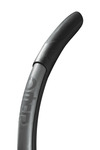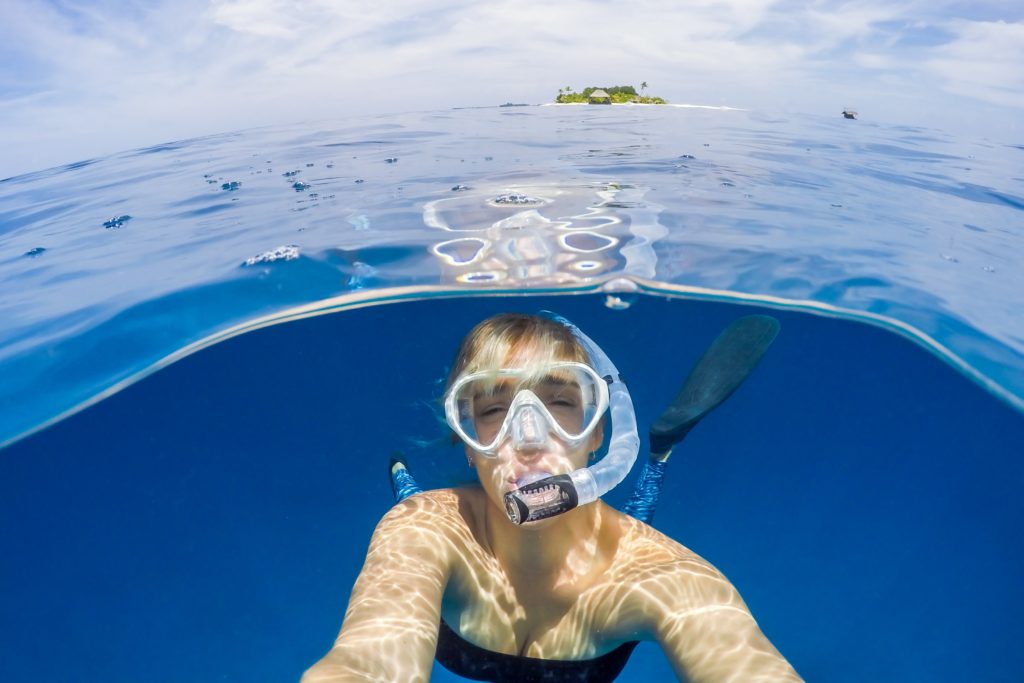There are some pretty impressive snorkels and choosing the best freediving snorkel can be overwhelming. Luckily freedivers and spearos have it easy and don't need all the gimmicks.
The modern advances in technology has changed everything. Even the simple snorkel has now become a technological masterpiece with purge valves and dry-tops that magically keep water from entering the tube. Niceties that are wasted on a freediver.
For freedivers it is a simple choice. All you need is a J-type snorkel without a purge valve or dry-top but with a comfortable mouth piece and some extras that you might not expect from other snorkels.
The Omer UP and the Cressi Supernova above show how big the differences are between the best freediving snorkel and the the best snorkeling snorkel.
Even though the Freediving snorkel seems to be basic it has everything that you need and nothing that you don't.
Let's run through a couple of features that you would expect from the best snorkels to help you choose the one right for you.
How to choose the best freediving snorkel features
Purge Valves
A purge valve is feature common on mid-range and better snorkeling and scuba diving snorkels but an unnecessary feature on freediving snorkels. This one-way valve is usually placed on the lowest part of the tube near the mouth piece and allows water to exit the breathing tube without letting any water in. A purge valve on a snorkel does add an element that needs maintenance and that can potentially start malfunctioning during a dive. For these reasons and the extra bulk that it adds freedivers avoid it.
Dry Tops
As with purge valves a dry-top is also a gimmick wasted on freedivers. For a beginner snorkeler a dry top does boost confidence since it seals the top of the tube and does not allow any water to enter. Snorkels with this setup is usually referred to as dry snorkels.
For young and inexperienced snorkelers that find it difficult to blow a snorkel clear this is a useful feature. For freedivers that break the surface when returning from a deep dive this is unnecessary. See our number 1 tip below.
Mouth Piece
When it comes to the mouth piece of a good freediving snorkel you should definitely get one that is made from a soft silicone rubber. Freedivers and snorkelers spend a lot more time at the surface with the snorkel in their mouth than scuba divers would. A soft comfortable mouth piece without sharp corners will make it a much more pleasant experience for you.

Length & Diameter
The longer the tube the harder it will be to breathe and the more "dead air" will remain in the tube. A longer hose also makes it a lot more difficult to clear the snorkel. The same is true for the diameter. As a freediver you want a balance between length and diameter. Luckily the best equipment manufacturers has spend a lot of time and money on R&D to get the perfect combination so all you need to do is pick one of our recommended freediving snorkels below.

Material
Snorkel tubes are made from either a hard or a soft plastic. The best snorkels like the Omer Up are made from a combination of both and even floats.
Hard plastic snorkels are strong and durable (and usually cheaper as well). The down side is that they aren't flexible. This is something that you do want since a rigid snorkel can break easier than a material that has some natural give in it and is also more likely to get stuck.
Something that you'll see on many snorkels but don't want on a freediving or spearfishing snorkel is a flexible corrugated hose. This floppy end is way too flexible and will flap around and cause a lot of drag whenever you dive underwater.
A foldable snorkel like the Aqualung Nautilus Sport on the otherhand is good for scuba divers that want to roll theirs up and stash it in a BC pocket but not for freedivers especially those that place their snorkel under their mask strap.
Snorkel Keeper
Most snorkels come with one of two styles of keepers: a figure of eight style silicone snorkel keeper or a hard plastic clip. The hard plastic clip can either be the "lift-to-attach" type which is preferred or the quick-release type.
The silicone keeper is best suited to snorkels with round tubes whereas the hard plastic clips are normally found on snorkels with oval shaped or square tubes. While the first mentioned has the benefit of being less expensive and easily replaceable it is a bit more tedious to connect to your mask than with other clips.
Some freedivers put their snorkels under their mask straps to keep it in place but the best thing to do if you are a serious freediver is to leave it at the surface. To do this you will need to attach your snorkel to your freediving float with a piece of string or get a floating snorkel and ask your dive buddy to grab it for you.
5 Top Freediving Snorkels
In no specific order here are our top 5 freediving snorkels:
Mares Pure Instinct Dual Snorkel
The Mares dual snorkel is a plain old-fashioned j-shape snorkel. Exactly what you are looking for in a Spearfishing and freediving snorkel.
Seac Jet snorkel
If you want to stand out or blend in then the Seac Jet is for you. It comes in 12 different colors, 5 of which are camo styles.
Omer Zoom Snorkel
If you want a snorkel manufactured by one of the best spearfishing and freediving brands then this Omer snorkel is the one. The pro version is foldable
Cressi Corsica
Where other brands charge a premium for their camo colors Cressi does not do that with their Corsica snorkels. Some versions come with a plastic clip style snorkel keeper which is not the best design and does not offer the best security.
Cressi Classic Snorkel
The Classic snorkel is a no frills cheap snorkel for snorkeling, scuba diving as well as freediving. It is an older design which means that the mouthpiece is not as comfortable as newer designs. Its shape is also not as streamlined as the more modern snorkels which results in it wobbling a bit on dives. Still, it is a solid and affordable snorkel for those on a tight budget.
Choosing any of these will be a solid choice and which one you choose might come down to things like price, brand preference or colors.
Snorkel Safety Tips
Snorkel in or out?
The best way to spot a novice freediver or someone that have just transitioned from snorkeling is to check whether they are diving with their snorkel in their mouths or not. Rookies often dive with their snorkels in their mouths where you will never catch an experienced freediver doing the same.
Diving with your snorkel in your mouth is not safe and should never be done. The reasons why you'll never catch experienced divers doing this is mainly because if you would suffer from a shallow water black your jaw would clench locking the snorkel in place and greatly increasing your risk of drowning.
Remember that while you are underwater, a snorkel in your mouth is essentially a funnel of seawater which will shoot straight into your lungs the moment you black out.
The last thing that you want to do when returning from a deep dive is to remove a snorkel from your mouth before taking a breath. Blowing a snorkel clear will be even worse...
This is a common and potentially dangerous mistake made by inexperienced freedivers, so next time you are out in the water and catch someone doing this help them right.
Diving with or without a snorkel?
Want another tip...? The guys at Freedive International has a popular article on their site about whether to dive with or without a snorkel...
The answer to this - as with many other questions - is: "It depends". It depends on what type of diving you are doing and what depths you will be diving at.
If you are spearfishing than you are probably doing most of your hunting in water less than 80ft deep. If this is the case take your snorkel with you. As a spearo you also want to keep an eye on the reef and surrounds when at the surface so a snorkel is a must really.
If you are freediving a line or reefs at medium depths then the choice is up to you and might depend on your setup. If you can tie your snorkel securely to your freediving float then do your breathe up with it and then leave it there.
If you are doing very deep dives than it is best to not use a snorkel or a mask. On these dives you will do your breathe up without a snorkel floating on your back. When depth matters so does drag and breathing up through a tube.
Did you find value in this article...? Please share it with your friends.













